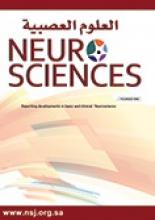Abstract
Objectives: To review the dynamics of neuroscience research in the Kingdom of Saudi Arabia (KSA) from 2013-2018.
Methods: Subject category of Neuroscience was selected in the SciVal feature of Scopus database, which includes all relevant categories of the field limiting it to Saudi Arabia.
Results: Saudi Arabia is ranked 39th in publishing neuroscientific research worldwide. The number of yearly published articles has increased from 123 to 332 during the time period between 2013 and 2018. King Saud University & King Abdul Aziz University & their corresponding regions namely Western and Central regions are the major contributors to publications. Neuroscientists working in Saudi Arabia have collaboration with scientists from all over the world. The top 10 preferred journals are all international. In subcategories of neuroscience, developmental neuroscience seems the one that needs attention.
Conclusion: Neuroscience research is on the rise in KSA. Older and well-established institutions like King Saud University & King Abdul Aziz University have taken lead in publishing neuroscientific research. International collaboration in all subfields of neuroscience is substantial. Eastern Southern and Northern regions and developmental neuroscience require more focus and funding.
Footnotes
Disclosure. Authors have no conflict of interests, and the work was not supported or funded by any drug company.
- Received November 8, 2019.
- Accepted February 11, 2020.
- Copyright: © Neurosciences
Neurosciences is an Open Access journal and articles published are distributed under the terms of the Creative Commons Attribution-NonCommercial License (CC BY-NC). Readers may copy, distribute, and display the work for non-commercial purposes with the proper citation of the original work.






